GENERAL MAINTENANCE CONDITIONS
The aquarium
The bigger it is, the easier it is to acclimatize the invertebrates. Do not consider
a tank of under 300 liters for a medium-sized anemone, accompanied by its clown
fish. A volume of 400-500 liters is the absolute minimum for a tank containing several
species of invertebrates. A maximum height of 50 cm is recommended to allow the
light to penetrate, as well as making it easier for the aquarist to intervene. It
makes sense anyway to install as large a tank as possible, as your enthusiasm for
these creatures is bound to grow.

Mounting a tank almost entirely composed of invertebrates,
with a few fish added, requires ample knowledge of these animals.
LOWERING THE PH IN A MARINE INVERTEBRATE TANK
The pH in a coral tank sometimes undergoes slight but regular decreases. When
it drops to under 8.3, it can be raised with sodium carbonate. Dissolve 5 g in 1
liter of water, and add 1 ml of this solution to each liter of clean water. This
process is repeated every day until a pH of 8.3 is obtained. There are also some
readyto- use solutions for this purpose available in the aquarium trade.
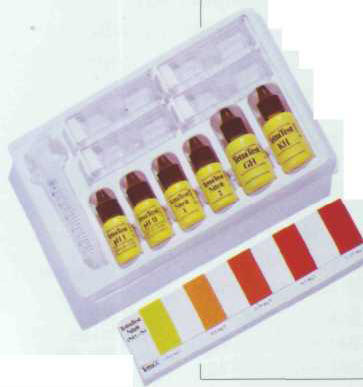
Easy-touse tests make it possible to control water quality,
which must be perfect in an invertebrate tank.
Water
This must be stirred vigorously: use a pump with an outflow equal to at least
five times, and up to ten times, that of the volume of the aquarium. Do not forget
that the water in an invertebrate tank will never be as agitated as in a natural
setting. The water must be very clear, to facilitate the penetration of light. It
is therefore vital to have good mechanical filtration, possibly in conjunction with
an air pump. Invertebrates are extremely sensitive to nitrates (NO3-).
A box filter is indispensable, and its volume must equal at least 10% that of
the aquarium.
It must be pointed out, however, that tanks containing true corals, or madreporites,
which form reefs can sometimes work well without this type of filter. In order to
facilitate the operation and reduce the burden of the filter, thus increasing its
efficacy, put the protein skimmer in its first section. As a complement to these
techniques, you are strongly advised to perform partial water changes, at a rate
of around 10% of the volume, once a week.
It is advisable to change the water the day after the weekly feeding session,
as this will help to reduce pollution. The specific gravity of the water must be
around 1.024, although it can go up to 1.026.
Light
This is extremely important, both as regards quantity and quality. Apart from
the aesthetic effect, lighting serves to enhance the development of Zooxanthellae,
the micro-algae which live in the animals' tissues and contribute to their equilibrium.
If the water is less than 50 cm deep, use fluorescent tubes as day lighting,
in conjunction with a blue tube. Deeper water requires powerful HQI lamps, again
combined with a blue tube. The lighting must be strong (around 1 W per liter of
water) and should be left on for about 13 hours every day. UV lamps are not recommended
for invertebrates.
More detailed information on lighting can be found in the chapter Equipment and
Accessories (page 226).
The substrate
Fine-grained soils are to be avoided, a size of 2-5 mm being perfect. The bed
must be calcareous and comprise sand made from corals and marine algae, which can
be complemented by crushed oyster shells to guarantee a moderate supply of calcium
carbonate.
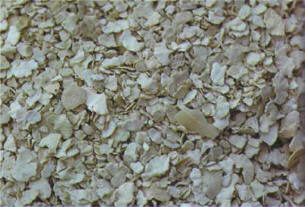
The substrate in marine tanks consists of coral elements
in fairly large grains.
ZOOXANTHELLAE
These are green micro-algae which live in the skin of Anthozoa and other organisms,
such as sponges or giant clams, a type of bivalve mollusk. They exchange substances
with the cells of their hosts. The carbon dioxide (CO2) resulting from the metabolism
of the cells - i.e. the oxidation of the foodstuffs - is collected by the Zooxanthellae.
These, in their turn, absorb nitrogenous and phosphorous substances, carry out photosynthesis,
and produce organic substances that enhance both their own growth and that of their
host. This type of mutually beneficial association taking place inside an animal
is known as endosymbiosis. The Zooxanthellae contribute, to some extent, to the
feeding process of Anthozoa, which therefore need only a very scanty external supply
of nutrients: some organisms, such as the anemones, need to be fed only around once
a week in an aquarium.
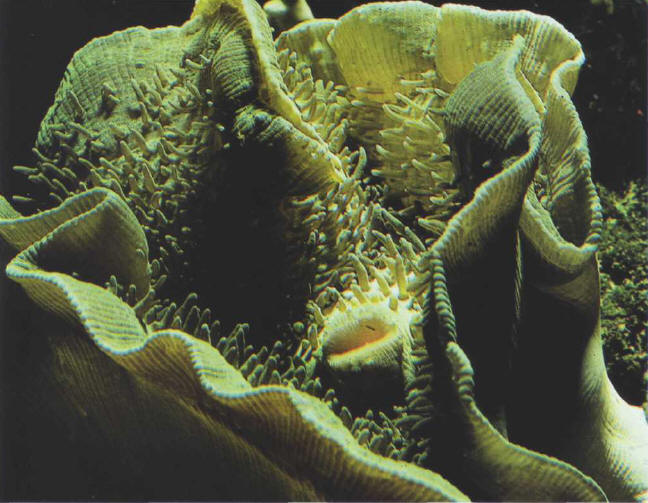
The green coloring of this Anthozoa indicates the presence
of a significant number of Zooxanthellae: this animal must therefore be placed under
fairly intense lighting.
The decor
This serves as a support for some animals. Create an aquascape in tiers or with
steps, and place the species on it according to their need for light. This is easy
to do with artificial materials, and the decor can be finished off with dead coral
and rocks.
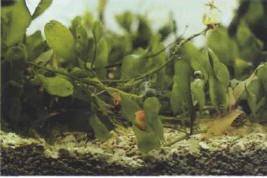
Caulerpa prolifera is a common alga in marine invertebrate
tanks.
Vegetation
Plants release substances that have a beneficial effect on invertebrates, although
as yet we still know relatively little about the mechanism of this process.
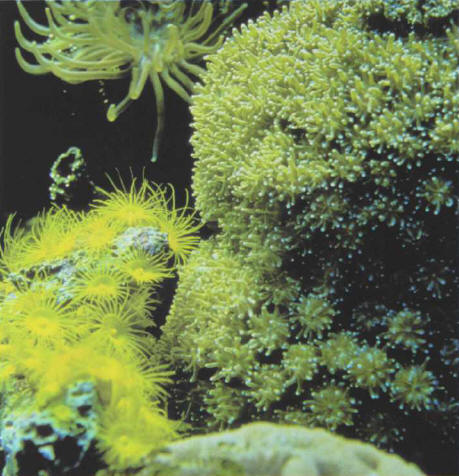
When well acclimatized, the Coelenterates soon deploy their
tentacles, which is a sign of good health.
Use algae of the Caulerpa genus, but do not allow them to become too dense.
In addition, remain on the lookout for the growth of certain filamentous algae,
as there is a danger that they might smother some sponges and delicate Coelenterates.
Acclimatizing invertebrates
As the characteristics of invertebrates' native waters are radically different
from those of the tank in which they will be placed, great care must be taken with
respect to their acclimatization. The container in which the new arrival has been
transported must be gradually filled with water from its future aquarium, to enable
the invertebrate to slowly adapt before it is carefully transferred into its new
habitat. The whole process takes about 1 hour. A quarantine period in an acclimatization
tank is recommended. When handling invertebrates, be aware of the stinging capability
of some species (such as anemones and madreporites).
|